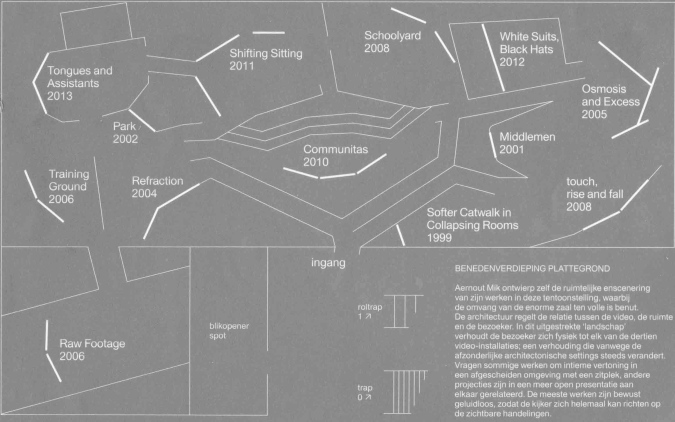Aernout Mik Videos
Mud, silence, soft violence
Groupdynamical and art-critical aspects in Aernout Mik’s video-installations
by Arnout ter Haar & Dineke Blom
Introduction
How do people behave in large groups? Are we as individuals still capable of intervening in the ordering of our society or is apathy ruling in Western society? These are questions that arise when visiting the exhibition Communitas by Dutch artist Aernout Mik that took place in the Amsterdam Stedelijk Museum from 4 May till 23 August 2013. An overview of his video-installations from the period 1999 – 2013 was presented there. The very first thing that comes to mind when viewing the projected images is the presence of large groups of people. For a group psychotherapist, but also for an artist, this is a subject that rouses the curiosity? In this paper we express our view on Mik’s work, combining the trained eye of the artist and the group dynamics perspective of the group psychotherapist.
In mostly staged images, Mik explores the social mechanisms that define human actions, referring to political and social topics such as economic depression, global crises, societal revolt and their representations in mass media. The title Communitas refers to the common as a phenomenon, but more specifically to the anthropological term for the stage where within a community social inequality has (temporarily) stopped and a sense of brotherhood emerges – for instance after an accident or some kind of religious ritual.
In every video shown in Communitas the viewer witnesses human group action, more often than not, with a threatening impact. Because there is no sound, the viewer is partly left in limbo: one can see what is happening, but doesn’t know exactly what is going on, or what caused the movement or what caused the apathy. Simultaneously projected images on big (and sometimes multiple) screens add to the confusion: one has the feeling that there is more going on than what can be seen, and complicated further because nothing is audible.
In the first part of this paper psychotherapist Arnout ter Haar gives an analysis of the group dynamics in one of the videos (Training Ground). It is his personal interpretation. In the second part artist Dineke Blom tells about her personal experience when viewing the carefully directed design of the exhibition.
Part I
Groupdynamical aspects in Aernout Mik’s video-installations
Synopsis Training Ground, 2006
On a desolated parking place a large amount of big trucks are parked close to one another. The drivers are standing or sitting next to their vehicles, some are cooking a meal or eating, they watch what is going on in front of them, but they don’t participate. The neglected parking lot is an open space; surrounded by weeds and shrubs, while in the distance some high buildings are visible. The parking lot is made of concrete, but parts are sandy or even muddy. At one side a checkpoint with a barrier is visible. Police officers are present, most of them wearing the green uniforms that are often seen in Eastern-European countries, but there are also police wearing green t-shirts or green sweaters: the majority are armed. A man in a grey suit with a walkie-talkie seems to be coordinating this operation. A search seems to be going to the rear of the parked trucks; people with bags appear, some alone, others in little groups, some are being pushed forward by the police. For the observer the image is crystal clear: somewhere at a checkpoint a control operation is being held. There are refugees, who have travelled illegally, hidden in the cargo of the trucks; perhaps they were part of organized human trafficking. These refugees have a different ethnical background from the police officers: most of them are from Africa, Asia or South-European origin, whereas the police officers have a Nordic appearance. The refugees are being ushered towards the centre of the parking lot by the police officers. Ostentatiously the police officers put on latex gloves. The refugees have to show their identity papers. They are being strip-searched and are forced to lie on the ground, face down. Once on the ground, their luggage is placed on top of their backs.
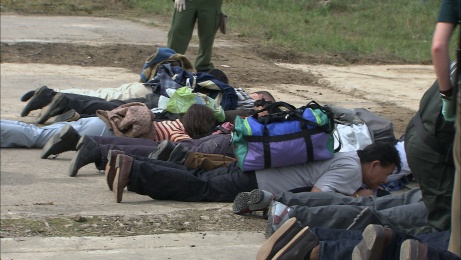
Still from: Aernout Mik Training Ground, 2006 2 channel video installation Edition: 4 + 2 AP Courtesy carlier | gebauer
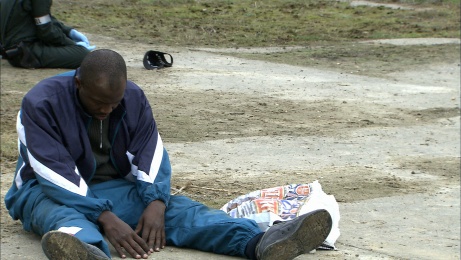
Still from: Aernout Mik Training Ground, 2006 2 channel video installation Edition: 4 + 2 AP Courtesy carlier | gebauer
Until now, this image is consistent and congruent with images we often see on television: a police controlled operation, strip-searching, sectioning people off, a strong we versus them dichotomy, a distance between two groups which is reinforced by putting on the latex gloves. However, when we look closer, the image is not that clear or consistent at all. Between the refugees lying on the ground, we can see more and more police officers sitting or lying down as well, some of them with an apathetic look on their face, others visibly upset, or weary from all the commotion, others with shaking limbs, and some appear to be physically or emotionally in a bad state. One of the refugees appears to suffer epileptic seizures -he has convulsions and is frothing at the mouth. Later we can see that a number of police officers also have saliva or foam on their lips. Some of the refugees and police officers appear to be wounded, and now we can see that some of the refugees are armed, with improvised guns made from wood, but also with the real guns that belonged to the police officers. Some of the police officers are lying on the ground face down, spread eagle, and with bags placed on their backs.
Now and then the group as a whole comes into action. There is an outbreak amongst the refugees, some try to escape behind shrubs, but are caught by the police officers and brought back to the parking lot. Meanwhile the truck drivers observe what is going on, leaning against their trucks, or cooking dinner at the side of the parking lot. In a big frying pan mud is being added to a sauce, after which the sauce is distributed among the onlookers.
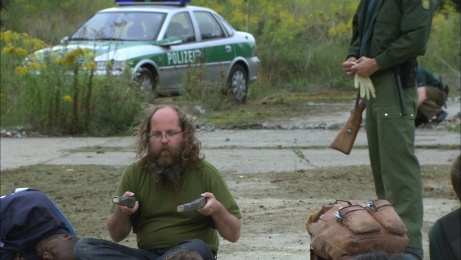
Still from: Aernout Mik Training Ground, 2006 2 channel video installation Edition: 4 + 2 AP Courtesy carlier | gebauer
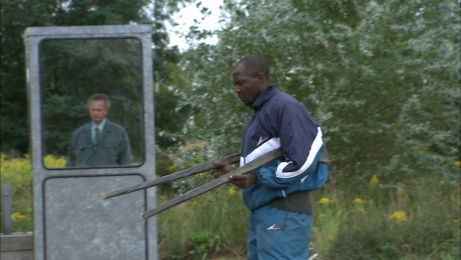
Still from: Aernout Mik Training Ground, 2006 2 channel video installation Edition: 4 + 2 AP Courtesy carlier | gebauer
Subgroups
The situation presented in Training Ground causes alienation, it is the transition of one social inequality into another, towards a situation where it is not clear who is controlling whom, who is capturing whom or who is arresting whom. This alienation even made me long for the situation in the opening scenes of the video, where it was clear who belonged to whom and you could tell who performed specific actions, even if the situation was repellent in itself. To my shame I have to admit that I would rather look at a maintained and familiar order – even when it is immoral and repellent – than having to look at the disorder and disruption that Mik is presenting.
What else comes to mind when viewing Training Ground? First of all one can distinguish subgroups. It is a feature of most of Mik’s work. The distinction can be between visible authorities or uniformed people on the one hand (for example soldiers, security guards, custom officers, police officers, firefighters, forensic researchers, nurses, cooks and waiters, judges and lawyers) and an audience, the public, bystanders or passers-by on the other hand. It brings up associations with images from Hirschbiegel’s movie Das Experiment (2001), based on the notorious Stanford Prison Experiment that Zimbardo held in 1971 (see also www.zimbardo.com and www.prisonexp.com).
The threat in Zimbardo’s experiment became real, which Hirschbiegel convincingly expressed in his film. Mik manages to instill this reality in his viewers as well. Interesting in the work of Mik however is that, although a clear distinction between subgroups is made initially, this does not lead to stronger polarization between the subgroups but to a gradual blending and to confusion between and within the subgroups.
Subgroups very often are based on the principle of presumed similarities. Members of a subgroup unite because they think that they are familiar or resemble each other in a certain way (Hoijtink, 2001). From a psychodynamic point of view, subgroups emerge as the result of splitting, a defense mechanism meant to control and manage our emotional inner state, by making a black-and-white distinction between what is entirely good and what is entirely bad, between them and us. In group psychotherapy subgroups often dissolve when their members feel emotionally safe and the subgroup loses its protective function. In Mik’s videos, subgroups also dissolve, but by no means because their members feel increasingly safe in the situation. New, transient subgroups emerge, without clear demarcations as to who belongs to which subgroup.
Regression
While watching Mik’s videos we witness group processes involving large groups. In psychoanalytical references a large group is defined as consisting of about 30 to150 persons who come together for a certain assignment or purpose. In such large groups, when the assignment is unstructured and ambiguous, regression occurs very quickly, resulting in feelings of anxiety, chaos, and panic for the group members. To escape this panic, large groups will exhibit narcissistic and paranoid characteristics while reorganizing themselves by means of primitive mental mechanisms.
Already in 1921, in Massenpsychologie und Ich-Analyse Freud emphasized the primitive and uninhibited behavior – behavior without reflection – of large groups, in which a sense of cohesion is attained mainly by projecting the Ego-ideal onto the leader of the group. This creates strong identification amongst members of the group and also strong identification with the leader. These mutual identifications create a sense of unity and of belonging, but they are at the expense of ego-functions in the group: perception and cognition is weakened, and hence strong impulses can emerge.
Nitsun (1996) stated that the regressive tendencies of people in groups are some of the most surprising aspects of human behavior, showing how thin the varnish of our civilization really is.
In contrast to Freud, Nitsun (thereby using the work of Bion) emphasizes that lack of leadership is responsible for regressive tendencies in groups. He also cites Brigham (in Nitsun, 1996; p. 110) who states that loss of identity in a group is an important factor in regressive tendencies, and contributes strongly to the anxiety that will arise in groups. In order to protect the fragmented self, we fall back on primitive defense mechanisms such as splitting and projective identification, resulting in a good versus bad dichotomy. To perceive the other(s) as bad, enhances the group cohesion and makes the threat of fragmentation less noticeable.
Nitsun named the construct for describing destructive processes that threaten group (psychotherapy) functioning, the anti-group. For Nitsun the source of these destructive processes is threefold: anxiety and mistrust regarding the group process, the frustration of narcissistic needs due to the group being perceived as neglecting and undermining, and finally the aggression that is being generated between the group members. Determinants of the anti-group are the above mentioned regression, but also survival anxiety, the failing of internal communication, projective identification, and envy.
When the group doesn’t succeed in creating any form of cohesion, the level of anxiety will stay unbearably high. On the most profound level these anxieties are about survival. When communication fails, the emotions cannot be expressed sufficiently, and are prone to be acted out.
Nitsun (1996) states that projective identification1 is a crucial medium in the formation of the anti-group. It acts as a force determining the potentially destructive character of the group because dangerous internal content will be deposited in the group (p. 125). When reinternalisation of the projected contents does not occur, its destructive aspects will remain active in the group. Zender (1991, cited by Nitsun) describes how the group becomes contaminated with negative effects and impulses as a result of projective identification. It is as if the members psychologically vomit on the group, making intense and unrealistic demands for nurturance.
Envy is readily evoked in every (therapy) group, and usually leads to a sense of humiliation and shame. As a result, envy often remains unexpressed, which enables it to continue its hidden and destructive work in the group. Envy harbors a wish to attack but at the same time harbors the fear of being attacked because of the envy.
In Mik’s videos both regression and anxiety – which in case of the illegal refugees could be a form of existential anxiety – are clearly perceivable. The same can actually be said about the police officers who exert their power by means of their uniforms and weapons, but still will experience existential anxiety in many aspects of their profession. There is no sound, therefore we can only make tentative remarks with regard to the failing communication. What seemed to be a well organized operation at first, directed by the man in a suit who carries a walkie-talkie, gradually develops into random actions which in turn lead to apathy, and eventually there is no communication whatsoever.
The convulsions of one illegal refugee sitting on the ground with foam on his lips, seems contagious, because later on we can see police officers looking apathetic, with saliva coming out of their mouths, vomiting. It brings to mind Zender’s above mentioned observation about the group becoming contaminated with negative affects and impulses, as if being vomited upon.
Envy could refer to the wish of the refugees to belong to the other groups who do have a legal status, such as the police officers or the truck drivers. No wonder they try to resist, to flee, or to change roles by dominating their attackers.
On regressive tendencies in large groups, Vamik Volkan published extensively as well. (see www.vamikvolkan.com). I shall give a summarized view of the elements of regression in large groups as described by Volkan (2006). When regression occurs in large groups, the first signs are that the members of the group lose their individuality and follow their leader blindly. The group creates a clear distinction between we versus them, and the we-group becomes more and more punitive against those they feel opposed to (the others, them). The group will use extensive introjective and projective mechanisms, and will experience massive mood swings, going from collective depressive feelings to collective paranoid expectations. The group feels justified to do whatever is necessary to keep its own identity. In this process the group members will use more and more magical thinking and will obscure reality. A new sense of morality will emerge, in which unwanted elements will be eliminated. Group members will use symbols of the group as proto symbols, in which adverse groups will be associated with dirt, debris, demons or with Untermensch physiognomy. The group will be preoccupied by blood in an exaggerated way, striving for a homogenous and purified group, where the blood becomes the bearer of both mental and physical identity of the group. The group finds it difficult to distinguish between beauty and ugliness and will transform its surroundings gradually in grey-brown amorphous structures (destroyed landscapes, muddy roads, disposal of debris and waste) as a symbol for what psychoanalysts would call anal sadism in an individual: to pollute their surroundings as if they were contaminating the soil by defecating on it. When the leader cannot maintain his authority in regressive groups, ultimately chaos will arise; sexuality and aggression will go hand in hand, causing rape and sadistic violence.
Regression in the video-installations of Mik
What of the above can be found in Mik’s Training Ground? As mentioned before, Mik’s work examines large groups of people, where some kind of leadership seems to be present, but the leader is not capable of maintaining order, and role diffusion and chaos emerge. In Training Ground there are moments when one subgroup is behaving aggressively towards another subgroup, and seems justified in doing whatever is necessary to maintain the dichotomy between ‘us versus them.’ There is a leader in a business suit, and the police officers wear uniforms that distinguish them from the illegal passengers they track down and direct towards the middle of the parking lot. What begins as a smooth operation, checking travel documents and luggage, degenerates quickly into a humiliating treatment by police officers towards refugees: the police officers ostentatiously put on latex gloves to strip-search the refugees and to inspect their luggage. The suggestion being made is clear: the refugee is dirty or contaminated. We can see aggression escalating: refugees are being forced to lie down while their luggage is being placed on their backs – senseless humiliation which can be construed as a sadistic policy. The fact that they are being forced to lie down on concrete, sandy or muddy ground, is in line with Volkan’s observation that a group in regression changes its own environment into a brown-grey amorphous structure. To one side of the parking lot we can see how the truck drivers add mud to their meals, and subsequently eat the muddy meal, thus showing a form of anal aggression. Blood as the bearer of one’s own identity is lacking in Mik’s videos, but he does show us other body fluids: saliva foaming on mouths. The association here is of dirty, animalistic low life; a drooling being, an Untermensch.
Mud
In one of his other videos titled Osmosis and Excess, Mik shows us the ugly and the dirty, the ‘grey brown amorphous’ even more explicitly: at first we see images of a large and modern pharmacy, well organized, with a shiny white floor. Later on we see that the floor has been transformed into a mud bath, with construction waste and shelves. Children are playing and sitting in the mud between rubbish piles containing strips of medication. In the video Lumber2 people are lying lethargically on towels, plaids and airbeds in the mud, as if all their energy has been drained. In the exhibition catalogue Mik explains the importance of the concept of entropy in his work. By entropy, Mik means that everything eventually will disappear, literally back into the earth. A kind of regression in ultima forma, one could say. Based on her field research on rituals of food, purity, taboo, dirt, and pollution in African tribes, anthropologist Mary Douglas explained in her book Purity and Danger (1966/2002) that taboos within a community protect the consensus on how that community is organized; they protect against social or intellectual chaos. In the face of ambiguity, a sense of discomfort or even threat is often present. The presence of dirt is never a stand-alone issue: in other words, dirt is never coincidentally present, but refers to a destructive system. If the existing order needs to be maintained, dirt needs to be avoided. Chaos is destructive of the present order and symbolizes both danger and power. Douglas refers to Sartre’s essay on viscosity. Viscosity is an in-between form, a state between solid form and fluid form. It is like a cross section of a process of change. Intermediate stages are dangerous, because they are neither one nor the other state. They are indefinable. The individual in transition is himself in danger, and transfers the danger unto others. The danger can be controlled by means of implementing rituals separating the individual from his old status -and separating him from the rest of the group, allowing him to publicly enter his new status. In many tribes this transitional stage (coming of age) is a marginal period in which the person in transition is seen as an outcast, not connected to the tribe; his behavior is expected to be a-social, wherein stealing and raping are permitted. Living thus on the margin is to be living in contact with danger and power. Dirt, obscenity, and lawlessness are relevant symbols.
This seems to be in line with the concept of communitas, the transition stage toward the (temporarily) disappearance of social inequality, in which the antagonisms (solid versus fluid, adult versus child, legal versus illegal, rich versus poor, etc) have ceased to exist.
Bystanders
Finally, a remark on the role of the truck drivers in Training Ground. They are – just like the visitors of the exhibition – spectators, witnesses who remain passive. Their position can be explained by the so called bystander–effect: ‘the more people witness a victim in distress, the less likely that they will intervene and offer help’ (Hoijtink, 2001, p.18). The presence of other people diminishes the sense of responsibility, one feels less addressed personally and thereby the impulse to act disappears. In this connection, the bystander-effect is also called bystander – apathy. The more ambiguous the situation, and the less clear it is what is going on, we tend to justify our own passivity. This passivity then will act like a model: bystanders notice each other’s passivity, and conclude unjustly that the situation can’t really be serious, otherwise other people would have intervened. ‘Collective passivity thus works as a reassurance’ (Hoijtink, 2001, p. 51). The truck drivers indeed are watching reassured, they even eat and drink, or cook their meal, like people having a pick-nick at a friendly sports event.
Concluding
In Mik’s video installations many aspects of group dynamics becomes visible. The forming of subgroups, dichotomies between us and them, leadership and authority, regressive tendencies, bystander-effect, chaos, and regrouping, it is all. It would be interesting, at a future exhibition of Mik’s videos, to invite a number of groups or group psychotherapists to the exhibition, ask them to observe what is going on, and compare their impressions3.
Part II
An art critical view of Aernout Mik’s video installations
Aernout Mik was educated as a sculptor and fairly early on in his career he focused on video as a medium of artistic expression. It was a gradual shift of focus: sculptural elements in his early work might pass for props that were left behind after a performance. Reversely, the later videos often contain an element of performance and include objects and scenes that evoke the earlier work. The element ‘performance’ is present not only within the works themselves but around them as well: literally, in the rooms in which the videos are shown. A case in point is the exhibition in the Stedelijk Museum, where museum guards posted near the video Tongues and Assistants are in fact part of the work. Such a performative intervention may serve as an example of the artistic means that Mik uses. Another example is the architectural design of Communitas about which Mik has commented that as a visitor you should be “aware of your environment, of the other visitors, of the interaction with the videos” (NRC Cultureel Supplement 2 and 3 May 2013). Camera movement, sound and silence are yet more examples. Together they enable Mik to create a reference for the viewer within which he can view and evaluate the works. The videos have no narrative sequence to speak of and where there is any, the narration is only one aspect that generates meaning. Moreover, the videos have a cyclical structure, having a specific length but one can view them at any moment in their time sequence, as they are played in a continuous loop. This characteristic of the videos was reason enough for me to focus on the non-narrative aspects of Mik’s work.
In this essay I explore how I as a visitor of the exhibition, became “aware of my environment, of the other visitors, of the interaction with the videos.” My account reads as a quest, rather than as an art historical analysis of the works. By revisiting the exhibition more than once, I was able to shed light on what the videos are about, or rather, on how they work. This approach clarifies how the concepts of imbalance, ambivalence, notions of what is real or not real, that Mik explicitly relates to in his work, are consequently conveyed to me (www.arttube.nl/nl/Stedelijk/Aernout_Mik). In the videos Mik offers specific rules to his viewers. In the videos, paradoxically, situations are acted out that seem to evolve from an absence of rules, as our account/analysis of Training Ground in section 2 of this essay (Ter Haar & Blom, 2014) elucidates. As a consequence in this essay, I switch back and forth between writing about the architectural design of the exhibition and writing specifically about the videos. I discuss a number of issues, such as the question of how the staged group situations depicted in the videos relate to the real world, beyond the confines of the museum. Which ‘environment’ am I made aware of? And who exactly are ‘the other visitors’? Are they confined to the visitors of Communitas or shall I, after having seen the show, observe my own familiar world through ‘Aernout Mik glasses’?
Inside and Outside
Obviously an exhibition that consists of video works requires a different presentation model than an exhibition of paintings or sculptures. There is the issue of how to deal with sounds coming from numerous videos. An easy solution to this would be earphones attached to the monitors. Another option is to present the works individually in spaces separated by heavy curtains that block the sound. Walls, lighting, curtains or other installation models all offer a frame – they demarcate where, how, and when one experiences a particular video work. In short, the choice for a specific form of presentation is not just a practical decision but affects the viewer’s involvement with the work. A case in point is the architectural design of Communitas, mentioned earlier, that was designed by Mik himself. It consists of pathways that lead you along the videos (fig.1). Sometimes several videos are shown together in one large space. In other cases the pathway tapers down to a narrow lane at the end of which a video is placed between two opposing walls. The walls built for Communitas are all slightly higher than the large format video screens. Perhaps it is because of this ascending openness that the design did not strike me as claustrophobic but rather as intimate. Silence predominates except for the last video, which happens to be placed towards the end of the parcours. Otherwise sound is absent. Mik’s design is no labyrinth, he told an interviewer: “However, the visitor must decide how to move through the space. [I have] consciously chosen for three pathways. That feeds the uncertainty, in the same way that the people in my videos are never secure.” (Van Lent, 2013). This exhibition will demand a full commitment from the visitor; this much becomes clear even before the visitor set eyes on the first video. Directly at the entrance is a three way cross point where one must decide which corridor to take. Only through the left corridor one can distinguish vague moving images in the distance.
I visited Communitas several times. On my third and last visit the exhibition struck me as a whole entity, as an organism that absorbs the visitor. At a certain moment I found myself in a narrow space where two walls turned out to be the rear sides of video screens: one of Park and the opposing wall of Shifting Sitting. I had the sensation of being in the innermost circle of the exhibition, in the belly of the organism so to speak. Something similar was the case when I noticed shadows crossing the projected images on the video screens. These turned out to be cast by visitors who were walking back and forth along the backsides of the screens. In short, the architectural design seemed to be intentional in the sense that it made one think in terms of ‘inside’ and ‘outside.’
Silence also accentuated one’s sense of being part of a whole. At an exhibition of moving images one would expect that there would be sound and absence of sound would become instrumental. At Communitas silence is not functional solely in the way that the accompanying floor plan tells us: “so that the visitor can focus on the visible actions.” The absence of sound unites the visitors and thus it creates a group. As a group we move in a silence that is not manifest. Once thus united I become aware of our mutual movements: we walk, lounge on bean bags, or walk up the steps of a platform where we stand still, turning our heads and shifting our weight from one leg to another. Everyone moves. Mik also explicitly points to our moving selves: the dividing wall between the two passageways at the beginning of the exhibition jumps from opaque to transparent, so that in one moment I see myself walking and the next moment a fellow visitor appears on the other side of the wall. I imagine that this emphasis on movement makes one susceptible to the movements that one sees on the videos, regardless of their narrative content.
With his staging Mik seems intent on creating a group. I am addressed as an individual (‘do you turn left or right?’); I then have the sensation of being part of a whole, connected with my fellow visitors and even to a certain extent with the characters in the videos, and ultimately I have a sensation of being left in the cold. Am I part of a group or not? This feeling corresponds to what the videos evoke (see part I of this article, Ter Haar & Blom, 2014).
Visible gestures, imaginary observer
In the silence that reigns “the viewer can fully […] concentrate on the visible actions and gestures” (quote from the folder; translation DB). I assume that these are the gestures performed by the characters in the videos. Before I describe these gestures, on the basis of two or three videos, I want to raise a question: how should one define ‘actions and gestures’ in the videos and who performs them? As to the latter: obviously it is the characters in the videos who walk, stand still, gesticulate, and jump up but it is not only them. When I call the exhibition to mind and overlook the exhibition floor as if from a bird’s eye view, what I see are movements: fast, slow, with jumps and starts and then again flowing, sometimes stopping abruptly, with no apparent logic. These are not the kinds of movement that a CCTV camera would register, nor the kind of camera movements in a documentary film, where one has an immediate sense of what connects the images.
This sea of undulating, jolting, abrupt images brings to mind the Google Glass, the glasses with integrated camera. As you walk, cycle or otherwise move around wearing this device, you can register everything that your camera catches sight of – without anyone noticing they are being filmed (unless of course someone recognizes your Google Glass). The gadget resembles another device: the simulator. Both make use of a so-called head mounted display; no matter which way you turn your head, you will always stay within the picture frame. An important difference, however, between the two devices is the fact that Google Glass images are present in the real world, whereas the images seen through the display of a simulator exist in a virtual reality. In The New Yorker of 5 August 2013 Gary Shteyngart, one of the earliest Google Glass wearers, recounts how he nervously gives instructions to his glasses: ‘O.K., Glass, take a picture. O.K., Glass, record a video.’ No matter how fast he swerves to where the next action is, zooming in on a specific detail that calls for closer inspection and zooming out again, he always lags behind. He keeps scanning his picture frame for meaning or at least for an indication of what connects the separate images. In some of Mik’s videos I sense a similar restlessness. The unsteady nature of the images affects me instantly, before I even begin to make sense of what the persons in the videos are doing. It is for this reason that I define ‘gestures’ in Miks videos in the first instance as movements of the camera. Whoever it is that handles the camera acts as one of the characters, being completely absorbed in the scenes he/she is filming; I shall call this camera person the imaginary observer.
The Google Glass wearer is flopped on his bed exhausted, defeated by a full day’s load of images and by the impossibility of seeing connections between them; finding no rest for himself. I can imagine that the imaginary observer who handles the camera in Mik’s videos is in a similar predicament. As for myself, I also felt an urge to create connections between the images. But unlike the restless Google Glass wearer, I surrendered for the time being to the complex situation, captivated as I was by the images. I was willing to capitulate so as to move along with them.
Movement
The camera movements condition the viewer in a subtle way. When I approach a video the first thing I am aware of are images moving with a distinct rhythm and their flow draws me closer. I shall reconstruct how I caught sight of the video touch, rise and fall, which was positioned next to the video Softer Catwalk in Collapsing Room. The screen of Softer Catwalk in Collapsing Room was fixed between two walls of a narrow corridor (see map). I sat down on the bench in front of it. After a while I stood up and walked in the direction of touch, rise and fall. My eyes followed the slightly slanting wall and from this angle I approached the work. Touch, rise and fall consists of two projection screens that are attached to each other in an angle of approximately 1600 so as to follow the curve of the wall. The line of sight ends in a void, i.e. beyond the end of the wall there is only the dark space of the exhibition room. My glance could be pulled without distraction into the direction of the video with its ‘visible gestures.’ From where I stood these gestures struck me in the first instance as just movements and I tuned in on them unawares. This is the subtle conditioning I mentioned above; it is how one is pulled inside the works’ enchanted circle. When this is the case, one is less inclined, as a viewer, to disengage from the work. Even if it turns out that one cannot make sense of the ‘visible gestures’ performed by the actors, one still wants to stay with the images.
Sense experience
Touch, rise and fall depicts a number of scenes situated in an airport, in full color and with no sound. Travelers are frisked by airport personnel; they stand, arms spread, under detection portals. They passively undergo the extensive inspection of their bodies and their luggage.
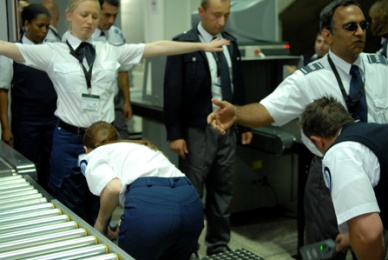
Stills from: Aernout Mik Touch, rise and fall, 2008 2 channel video installation Edition:4 + 2 AP Courtesy carlier | gebauer Set-Photos taken by Karl Bongartz
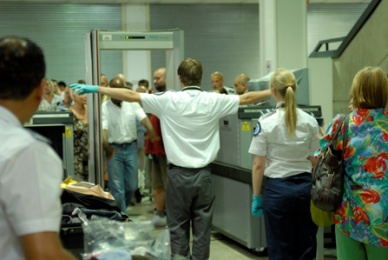
Stills from: Aernout Mik Touch, rise and fall, 2008 2 channel video installation Edition:4 + 2 AP Courtesy carlier | gebauer Set-Photos taken by Karl Bongartz
Meanwhile, an endless stream of objects slowly rolls over the conveyor belt toward the x-ray machines. Safety personnel inspect these knickknacks. They go about slowly but purposefully: some objects are cut open and their contents scrutinized. The camera swerves from close-up to overview, from left to right and back again. It is difficult to detect a logic by which the images are spread across the two screens. What is striking is that hardly an effort is made to fit the actors ‘properly’ within the picture frame. Sometimes only half of their face is visible or the face has fallen out of the picture frame altogether. From the way in which the camera focuses on persons and items, one cannot understand what is important and what is not.
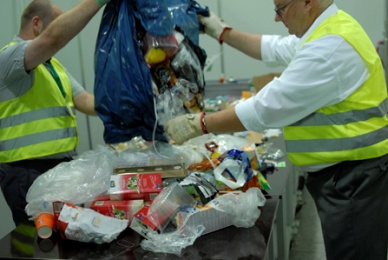
Stills from: Aernout Mik Touch, rise and fall, 2008 2 channel video installation Edition:4 + 2 AP Courtesy carlier | gebauer Set-Photos taken by Karl Bongartz
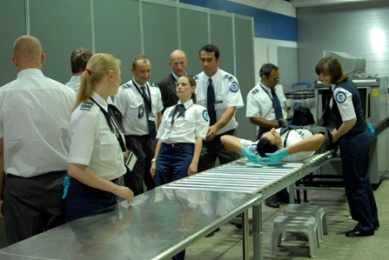
Stills from: Aernout Mik Touch, rise and fall, 2008 2 channel video installation Edition:4 + 2 AP Courtesy carlier | gebauer Set-Photos taken by Karl Bongartz
The scene shifts to what seems to be an area where the airport personnel take their breaks. Everything emanates boredom: small groups of people are playing games; someone is resting on [one of the] bunk beds placed in the middle of the room. Others are fidgeting with small objects that they take apart and then seem to somehow put back together. The actors never step out of their roles, their behavior is utterly convincing, no matter how absurd the situations in which they find themselves. Everything, from picking at silly objects to passively moving into the direction of the detection gates, looks authentic. I think: is this really happening and this is not for real. The two perceptions have equal weight. Of course nowadays we can quite easily imagine a situation of endlessly waiting in the departure hall of an international airport and Mik plays along with this ability of his viewers. He also gets under our skin because we see different hands belonging to different bodies endlessly repeating the gestures of touching, raising, and letting fall – a choreography of mindless rearrangements. It is useless to search for a ‘solution’ to these gestures. In an interview, (Kellerhuis, 2013) Mik stated that for his work, which lacks a story, his viewers should ‘perhaps open themselves up just a bit more. […] besides a cognitive experience, it is also very much an experience of the senses.’ I indeed shift into a different way of looking, not primarily aimed at understanding but at experiencing. The process that Mik describes could actually have worked the other way around: the installation of Communitas as a whole would begin to open itself up to the viewer and then attract the viewer towards the works, as if a hand was motioning to come closer.
Simulation, interaction
In Tongues and Assistants I also felt a ‘beckoning hand.’ I saw this work early one morning. I was one of the first visitors of the exhibition that day. In a corner opposite the video stood a stack of plastic chairs. I stood watching for a while, then took a chair from the stack and without thinking I positioned myself very close to the two big screens. Shortening the distance had a surprising effect. From a three meter distance, I ‘look at’ the scene, whereas from a one meter distance I become physically involved. The absence of sound enhanced this feeling. Sound would have enveloped me and consequently I would perhaps feel less compelled to move closer to the video given the sheer visual effect of the images. It may not have been a coincidence that the chair I sat on was identical to the chairs in the video.
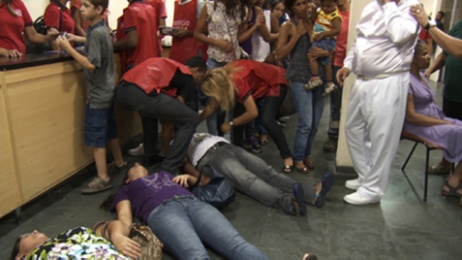
Stills from: Aernout Mik Tongues and Assistants, 2013 2 channel video installation Courtesy carlier | gebauer

Stills from: Aernout Mik Tongues and Assistants, 2013 2 channel video installation Courtesy carlier | gebauer
The scenes in Tongues and Assistants are not staged. They are a registration of a large Pentecostal church gathering in Sao Paulo, Brazil. On the two screens one sees a heaving crowd of people listening to a preacher’s uplifting words. As there is no sound, the cliché, ‘a deafening silence’ seems very appropriate to use for this video. The worshippers go into trances, their exaltation wears out and flares up again. The camera zooms in on completely disparate behaviors as well: people stare absentmindedly, check their cell phones, or are busy with what looks like collecting money or vouchers. The camera turns from one corner to another, zooming in on faces, hands, shoes, and panning out to a bird’s eye
view of the excited crowd.
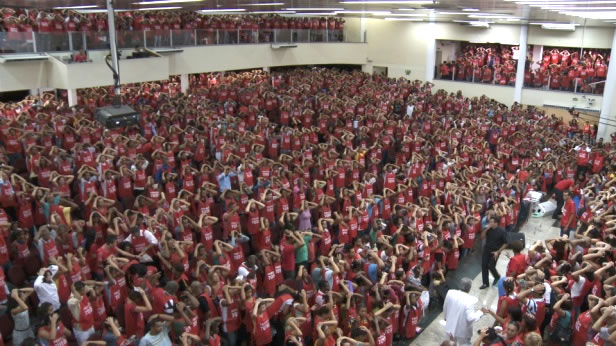
Stills from: Aernout Mik Tongues and Assistants, 2013 2 channel video installation Courtesy carlier | gebauer
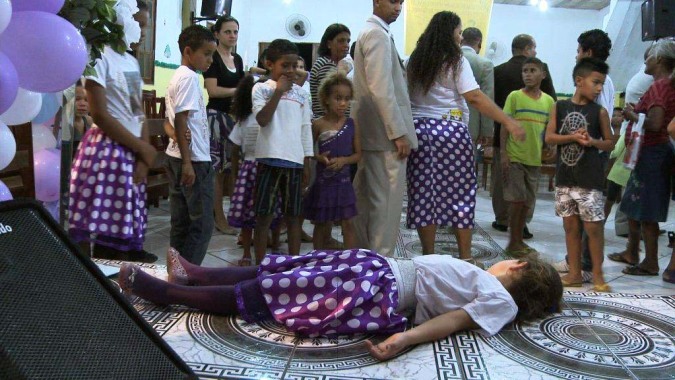
Stills from: Aernout Mik Tongues and Assistants, 2013 2 channel video installation Courtesy carlier | gebauer
At a certain moment the camera swerves over the heads of the crowd and suddenly accelerates. This moment reminded me of wildlife documentaries showing images of stampeding animals, filmed from a helicopter that suddenly accelerates and swerves upwards. Watching this video, I have the sensation of being lifted, as I follow the sway of the camera. In Tongues and Assistants, such maneuvers, in combination with the images themselves, give me the sense of being in a simulator. This illustrates just how compelling the images are and how closely involved I am in the scenes before me.
This brings me again to the imaginary observer who controls the camera in Mik’s videos. Both in Tongues and Assistants, touch, rise and fall, and in the video Training Ground, I am very much aware that I observe the images through the eyes of this observer, because of the explicit camera movements. If anyone can make sense of the chaotic situation in Training Ground (described by Arnout ter Haar in part I of this article), it should be this (camera) person. But what does his first rank position yield? I notice how he tries to keep up with the nervous gestures of the characters. This effort is apparently doomed to fail because more often than not only a fragment can be seen of an action; a face or the grounds where it all happens. As a viewer, I cannot but follow his eyes, I have no other alternative. The film is not an objective rendering of an otherwise absurd situation. On the contrary, it is a subjective account made by someone who seems to be groping. The disconcerting message might be that there is no position whatsoever from where one might get a coherent view of the situation, of the ‘gestures.’
The view of this camera person will never fall outside of the picture frame, or so it seems. I am tied to his glance and pulled into a kind of cyberspace: into a world in which behavior is simulated. The point of a simulation is that it provokes me to show specific behavior. But what kind of interaction is expected from me? It’s true that I am in the ‘interaction mode,’ Mik has attained that much. But meaningful interaction becomes difficult when I do not understand the behavior of the persons around me.
Inside and outside the museum walls
This conclusion is an overture to the video Raw Footage. The images of Raw Footage are ‘real’: Mik has used documentary footage from the war in former Yugoslavia that was never broadcast on television. One fragment shows people running through a street. A man holds his briefcase over his head as if to protect himself, a woman protects her head with a plastic shopping bag. How can one tell if these people are fleeing from snipers’ bullets or from a threatening shower of rain? There is no sound so we cannot hear shooting if there was any. Another fragment, which does have sound, shows men waiting around, their rifles within reach, in a building that is all but destroyed. They loiter in a similar way as the security personnel of touch, rise and fall. Kristina, an artist friend from Serbia who joined me on one visit to the exhibition, translated a few of their barely audible words: ‘Shall we shoot?’ At which point the men come into action – from sheer boredom, was my impression. The images show an uncanny resemblance to those on other videos in the exhibition. The characters in Softer Catwalk in Collapsing Room for example, wander through a collapsing house steering clear of falling debris like sleepwalkers. They experience the same fundamental existential uncertainty as do the ‘real’ actors/characters who run for protection in a street in former Yugoslavia. This existential uncertainty runs like a thread through the exhibition and Raw Footage in particular, adds a sense of urgency to the exhibition as a whole. The television footage of Raw Footage is potentially explosive because you know that it is not staged but also that it was filmed in a war situation. Paradoxically the images are a safe distance from the viewer. They are television images; tele-vision by definition means that what you are watching is not close by, as Lambert Wiesing writes in his book Artificial Presence: Philosophical Studies in Image Theory (Wiesing, 2010, p.82). You can distance yourself from the reality behind the images. However, in connection to Mik’s videos, I would hold that the viewer is prepared to interact with the images. The exhibition as a whole (videos and installation together) has gradually brought you into this mindset, making it difficult to let go of your willingness to connect.
In a simulation, Wiesing writes, “something is tried out, yet not in the empirical, but in the imaginary – albeit in a pictorially constituted imaginary.” (2010, p.101). Mik’s work challenges one to reflect with the strength of one’s imagination, which is indeed, like Wiesing notes, an activity not primarily cognitive but as much, or foremost, an experience of the senses. It is quite a challenge then to imagine the uncomfortable situations depicted in the videos and to envision experiencing them directly. What happens is that one connects the scenes depicted in the videos to situations in the world beyond the museum walls. There I see the ‘other visitors’ that Mik mentioned. I see them in my own environment, a place that turns out to be less familiar than I had thought. In my view, this is the ‘Aernout Mik glasses’ that Mik offers his viewers and through which they are encouraged to contemplate their own situation – or perhaps I should rather say: our collective situation.
Part I and II
Artcritical and group dynamical perspectives: an integrated view
As Mik indicates, the staging of the video installation fuels a sense of insecurity in the visitors, mirroring the insecurity of the figures in his videos. It invites the visitor to think in terms of ‘inside versus outside’ of ‘we versus them.’ The staging also assembles the visitors into a group, only silence connecting them. Subgroups are also created. In Mik’s images these are initially clearly demarcated but gradually they overlap and intermingle, becoming blurred. The subgroups that are created among the visitors are fleeting, created from shared motions and gestures such as briefly sitting down on beanbags or on plastic chairs while watching the same video images, or strolling past them, or by sharing the emotions that the images evoke. At the same time, though, the visitor senses being left out of something and this too seems to run parallel to what the persons in Mik’s videos transmit. The viewer is left with a desire to create order and cohesion in what he observes. Apparently we prefer to see a well-organized whole – even if its content is clearly abject – rather than lingering in a disruptive vacuum and realizing the alienation that comes with it.
Freud has written about regressive tendencies in groups. We described earlier on how the views of Freud, Volkan and Nitsun helped inform Mik’s images. At the same time, Mik subtly nudges viewers to take part in the scenes that he presents, thus challenging the viewer. We cannot make sense of the videos, which lack a narrative structure, if we use only our cognitive functions. We have to open up to the images; it is a matter of experience more than of cognition. This more profound experience can expand our perception and give access to our intuition. However, it will also confront us with less agreeable feelings such as our own regressive or frightening impulses that we generally try to repress. In this way Mik manages to seduce us as well as confuse us.
It is not only the viewer who opens up to the work, the staging of the exhibition also facilitates this expansion. It reinforces the sensation of entering another person’s psyche by sensing another’s anxiety, aggression, power, and filth, and then viewing it on a large video screen. As indicated earlier, Mik makes a strong appeal to experiencing rather than understanding a situation. As a result we tend to relate to the images on a more profound level. The nature of these disturbing images confronts us with a fear of a fundamental existential uncertainty. In order to escape this fear, large groups of people tend to demonstrate narcissistic and paranoid behaviors and then reorganize this anxiety using primitive mental mechanisms. The visitors of Communitas must also reorganize their motions upon viewing Mik’s images so as not to be overwhelmed with anxiety. In order to avoid fragmentation of self, we resort to the strategy of splitting into entirely good versus entirely bad as a defense mechanism. The video images augment our confusion when we try to decide with whom to identify (we) and who to locate with outside ourselves (them). Fortunately, as a visitor one can keep enough distance from the images to prevent oneself from being pulled deeper into the regression. We want to believe we will not be contaminated by the filth and the mud; we regain control over ourselves and realize that we are observers who entered Mik’s universe on our own initiative and that at any moment we can step out again.
In an interview in the Dutch newspaper De Volkskrant (Pontzen, 2013), Mik stated that his work “is always concerned with the relation between a museum visitor and the group of people that I show in my video images; with the phenomenon that motivation and behavior of the group members catch on to the museum visitors observing them. On a psychological level as well as physically.” When we leave the exhibition and enter the outside world, we find ourselves back in a familiar world where we find order and a clear perspective, a world in which cognition triumphs over impulses. Still, something has shifted: on further consideration, our familiar reality seems somewhat less familiar, even the passers-by in our streets look different once we have borrowed and looked through Mik-glasses. Mik allows us to experience what we normally tend to avoid: a penetrating look into our own psyche, into our existential fears and our primitive defenses.
September 2014 © Arnout ter Haar, Dineke Blom
